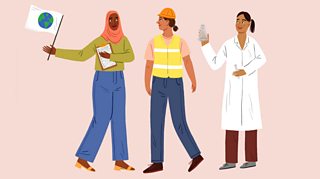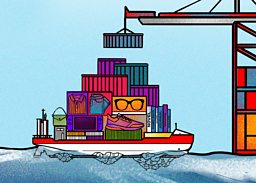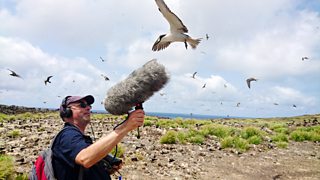Six extraordinary ways people are fighting climate change
Trying to reverse climate change is possibly the biggest challenge humanity has ever faced. Luckily, there are some amazing minds around the planet working on the problem from every angle, and you may be surprised at some of the solutions they’re coming up with.
Radio 4’s podcast 39 Ways to Save the Planet looks at these solutions in detail. Here are six particularly brilliant examples from the show...
1. Educating girls

Improving education throughout the world seems like a no-brainer. But increasing education for girls in particular doesn't just have social and economic benefits, it also helps fight climate change. This is partly just because they start having babies later as they are in school for longer. If all girls finished secondary school, by 2050 the population could be about 840 million fewer than currently predicted.

However, when it comes to climate change, population can be a controversial subject. People in poorer countries have tiny carbon footprints compared to those in rich ones. But with the planet's resources under strain, growing populations do matter.
Educating girls is about much more than population statistics though. Women who are able to take part in work, business and politics can be the secret to boosting climate protection. Studies suggest that increasing the number of women in national parliaments can lead to stricter climate policies, fairer outcomes and lower emissions. All good for the planet.
Today, many charities are providing significant funding for education – and it’s working. Across the world girls' education rates are rising, with countries like Bangladesh increasing secondary school enrolment for girls from 39% in the 1980’s to almost 70% today.
Click here to learn more about how educating and empowering girls can change the world in unexpected ways.
2. Making a lot more stuff from bamboo

Bamboo is the fastest growing plant in the world. It can grow up to a metre a day and it absorbs carbon much more quickly than trees. Engineered bamboo can also be stronger than steel. All this potentially makes it a super sustainable material for constructing furniture and buildings. In China, bamboo used to be seen as "the poor man's timber", but now it's having an image makeover. Bamboo-based products can act as a sustainable, low-carbon alternative to steel, PVC, aluminium and concrete.
Growing bamboo also has other ecological benefits: It tends to be pest-resistant and can boost soil fertility, prevent erosion and lower the risk of flooding.
Arief Rabik runs the Environmental Bamboo Foundation in Indonesia, a charity dedicated to restoring land and capturing carbon with one thousand "bamboo villages". Each settlement will be surrounded by about 20 square kilometres of bamboo forest mixed with crops and livestock. He wants to expand the idea to nine other countries. “Collectively, they will absorb and remove out of the atmosphere one billion tonnes of carbon dioxide every single year”, Arief says.
To learn more about marvellous bamboo, click here to listen to the episode.

3. Using the law to fight big polluters

What do lawyers and trees have in common? They both want to lock up carbon! Climate lawyers are increasingly using the strong arm of the law in the fight against climate change. In fact, the legal system is one of the most powerful weapons available to keep polluting companies and governments in check. And it’s not just environmental law coming to the rescue. Smart lawyers are getting creative, using human rights laws, employment laws and even company law in the fight against climate change.
Recently, an investor group holding just £25 of shares managed to stop an entire coal plant being built in Poland. How? They used corporate law to sue the directors: The court judged that opening a new coal plant was simply illegally bad business.
To hear more about the canny lawyers fighting climate change, click here.
4. Hunting down gassy fridges

Every fridge, freezer and air con unit contains chemical refrigerants – like hydrofluorocarbons (aka HFCs). But the insulating power which makes HFCs fab in fridges also makes them a dangerous blanket for the world. In fact, HFCs’ global warming potential is so potent – much more so than CO2 – that in 2017 world leaders agreed to phase them out. It's a move predicted to reduce global heating by a huge 0.5 degrees.
Some have been calling us the equivalent of the Ghostbusters, but for refrigerants.Maria Guti茅rrez
But the number of fridges and air conditioners already in existence is massive. With most refrigerant emissions happening at the end of life, recycling and safe disposal is mission critical. Luckily, across the planet, specialist teams track down and destroy dangerous refrigerant gases. Maria Gutiérrez is the director of international programmes at Tradewater, a company that seeks to find, secure and destroy the gases safely. They often scour old warehouses and waste disposal sites, looking for the offending refrigeration units. "Some have been calling us the equivalent of the Ghostbusters, but for refrigerants", says Gutiérrez.
Click here to follow the refrigerant hunters on their mission.
5. Making ships more slippery

When it comes to world trade, a few tiny creatures can be a huge drag.
Shipping is vital to our global economy – 90% of all the world's trade travels by boat, and this shipping accounts for 2% of all man-made emissions. Seeing as we’re so reliant on these ships, one little stowaway sea creature – the barnacle – is causing us a big problem. Boats encrusted with barnacles, limpets and mussels can use 25% more dirty marine diesel than “slippery ships” with smooth sides – pushing up emissions and adding a whopping £22 billion a year to fuel costs.
To reduce the carbon commotion caused by these barnacles, experts are finding ingenious ways to make our ships more slippery. Barnacle psychologists (yes that's a job) are advising engineers how to make their ships less attractive to these gas-guzzling hitchhikers. Ingenious solutions from special UV paint to hull-cleaning robots could radically cut the carbon cost of shipping our stuff. The race is on to find the best way to keep our ships slippery.
To hear more about creating slippery ships, click here.

6. Creating super rice

Did you know that growing rice has a high carbon footprint? In fact, rice has the same carbon impact as aviation! This is because most of our rice is currently grown in paddy fields flooded with water to drown competing weeds. But this water stops oxygen from reaching the soil, which leads to methane being produced. Methane is a gas which, per kilo, can cause 25 times more global warming than carbon dioxide.
To combat this climate threat, scientists are leading a rice revolution. They are breeding new varieties of rice crop that can thrive in dry fields instead, saving water, helping farmers and reducing methane emissions. They've studied 650 new rice varieties from the International Rice Research Institute and they’re using the best strains in their breeding programme. It is hoped that within a decade most of our rice will be grown in this much less gassy way.
Click here to learn more about the rice that's saving the planet.
The illustrations for this feature were commissioned as part of the 成人快手's Climate Solutions project, in partnership with The Open University. Artist credits: Amelia Flower (), Rohan Dahotre (), Dandy Doodlez (), Kingsley Nebechi () and Sarina Mantle.
More eco-friendly content
-
![]()
39 Ways to Save the Planet
Tom Heap and Dr Tamsin Edwards uncover fresh ways to save the planet from climate change.
-
![]()
Our Planet Now
The 成人快手鈥檚 ongoing focus on the environment and the challenges facing our planet.
-
![]()
Explore more on environmental issues and climate change with The Open University.
-
![]()
Costing the Earth
Fresh ideas from the sharpest minds working toward a cleaner, greener planet.




